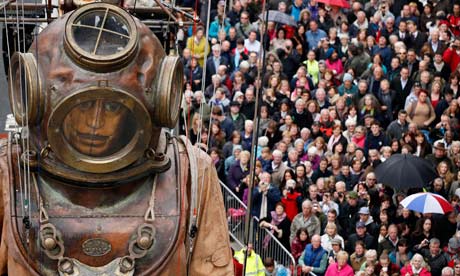
On Friday evening at Sea Odyssey I stood behind a family group as the not-so-little Little Girl and her dog were put to bed. What I found interesting was that this family weren't just watching the show, they were engaging with it on several different levels. Teenage daughter was taking pictures on her iPhone, and texting all the time, Mum was videoing it on her phone and when I spoke to them they told me that Dad had been tweeting for much of the day.
It's now accepted that theatre-makers will create work across platforms ,and using all the tools available to them to both make and market shows and build communities of interest, but the ways audiences engage with shows and access them is changing too. I first noticed it at the Sultan's Elephant six years ago when one of the images that has stuck in my mind most was not just of the elephant itself but of thousands of people standing on the Mall all with their arms stretched upwards as they used their phones to take pictures. It was, I think, those pictures as much as the TV coverage or reviews that draw an estimated million people out on the streets to see the show. After all when friends put up stunning pictures of a show on Facebook, it's probably a better advertisement than all the paid advertising in the world.
Then at NTW's The Passion last year it became apparent that the online manifestations of the show offered extra layers and interactions and points of entry for those who wanted them, or who simply couldn't be in Port Talbot that weekend. Of course all these instances I'm talking about refer to shows that are taking place outside rather than in traditional theatre buildings where no mobile phones and no taking of pictures is still very much the rule.
I certainly don't want hundreds of flashes going off as Gloucester has his eyes gouged out in King Lear any more than the next theatre-goer, although having said that I have no difficulty with dedicated tweeting rows, and it would seem to me that there would be some shows or performances that might particularly lend themselves to the relaxing of both the no-phones and no-photos rule.
But the idea that you must be present to experience it is being replaced by the suggestion that while it's best to be there, if you can't be then you don't have to miss it entirely. NT Live has proved that such digital approaches encourage people to go to the theatre rather than diminish demand. My experience at Sea Odyssey also suggests that even if they are there in person, audiences don't just want to consume passively, they want to interact with others also present, and to curate and document their own experience and give it shape and narrative.
NWT's The Radicalisation of Bradley Manning isn't just playing in Wales this week, it is also being live-streamed to a global audience. Again, it's not a ground-breaking idea, but what it is doing is demonstrating that theatre-going doesn't just begin with buying a ticket and end when the curtain falls. People clearly do want a more interactive theatre experience that allows them to engage with others who have seen what they've seen, and they want to share and discuss over many platforms.
As I've said before, this doesn't mean that traditional forms of theatre-going are on the way out, but theatre would be wise to be open, responsive to the desire of audiences to not just consume but to be engaged, to be heard and to be creative too. If theatre can use the tools available to collaborate with audiences on that, then its future is assured.

